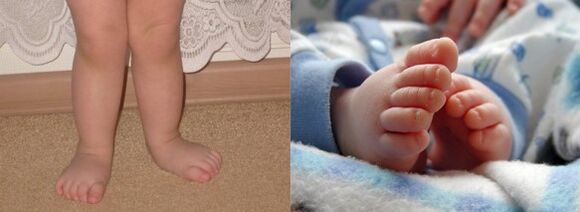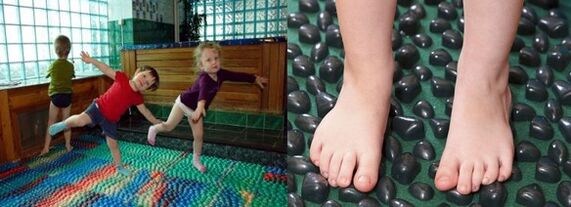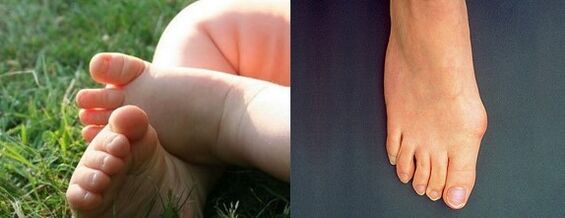Valgus deformation of the foot in a child is a condition in which a decrease in the height of the arches of the foot and X-shaped curvature of its axis are gradually formed.At the same time, the heel, along with the fingers, unfolds outwards, the baby has noticeable clumsiness and rapid fatigue.What to do if you find such changes in the feet in your child?First of all, you should seek consultation with an orthopedic physician, as well as understand the reasons that led to the development of Valgus stop.

What is valgus deformation of the stop?
Under this term, orthopedists are understood as the state of the foot in a child in which the distance between the ankles is 4-5 cm. The baby's knees should be reduced together and straightened.The heel and fingers of the legs with this pathology deviate out, and the inner vault is flooded inward.The child’s legs become similar to the letter “X”.In the event that not only the axis changes, but a decrease in its arches is also noted, the orthopedist is diagnosed with “flat-valgus deformation of the feet”.Why is this situation developing?
Causes and stages of the development of the disease
Valgus deformation of the foot in children can be either congenital or acquired.At the same time, congenital pathology is considered a consequence of intrauterine disorders at the stage of development of the lower extremities and can be caused by a wide variety of factors.In this scenario, it is possible to detect the ad-valgus foot in the baby in the first months of life.
The acquired deformation becomes noticeable much later - with the first steps of the child.These deviations can be associated with insufficient development of the ligamentous apparatus and various violations of the musculoskeletal system.It is noted that Valgus feet often occur in weakened children with severe muscle weakness.Also, the disease can be caused by the following conditions:
- congenital diseases of the connective tissue;
- non -prematureness;
- intrauterine pathologies leading to hypotrophy (low body weight);
- congenital lip of thighs;
- rickets;
- Cerebral palsy;
- polio;
- obesity;
- foot injuries (including long -term stay in gypsum).
The cause of Valgus Stop can also be incorrectly selected shoes for the first steps.Wearing soft and poorly fixing shoes can be the immediate cause of Valgus deformation of the foot.The development of the lower extremities is also poorly affected by the baby’s too early setting on the legs and the use of walking devices (walkers).
Whatever the reason that caused the formation of the AD-Valgus foot, one is one.The muscles and ligaments weaken and stretch over time, losing the ability to hold the foot in the correct position.
Signs of the disease

The first symptoms of Valgus deformation of the foot appear at the moment when the baby tries to take his first steps.When observing the gait of the child, it becomes clear that the baby occurs only on the inner edge, and not on the whole leg, as it should be normal.In the absence of treatment, the foot acquires a X-shaped form.The child quickly gets tired, complains about pain in the legs and discomfort when moving.In the evening and at night, swelling may develop.Valgus installation of the feet is also characterized by the fact that the boots are always erased only on the inside of the sole.
In addition to Valgus stop, there are other types of X-shaped deformation of the lower extremities.Wicked can affect the neck of the thigh with its congenital dislocation or dysplasia.The legs in the form of the letter "X" can also be curved in the area of the legs.All these diseases are usually combined with each other and are the result of the same changes taking place in the ligamentous apparatus of the lower extremities.
How to recognize the disease?
The plane-valgus installation of the stop is well determined using an X-ray examination.The picture is taken in three projections.In the radiograph, improper installation of the legs is clearly visible - and this gives every reason to make a diagnosis.In addition, computed tomography is performed - a method that allows you to calculate all the necessary morphological parameters of curved feet.And finally, the doctor necessarily performs Podometry, during which the load on different departments of Valgus feet is evaluated.
Some types of deformations require additional examination.To determine the condition of the hip joint, an ultrasound is carried out.In addition, every child who has been diagnosed with Valgus deformation of the foot should visit a consultation with a neurologist to exclude diseases of the nervous system.In some cases, the disease is formed not only with insufficiency of the ligamentous apparatus, but also with some pathological conditions of the brain and spinal cord.
The consequences of valgus deformation of the stop
A change in the child’s set in the child inevitably leads to the formation of X-shaped curvature of the legs.Also, the improper position of the pelvis cannot be avoided, and as a result, posture disorders at an older age.In many cases, Valgus feet leads to the development of flat feet - a source of constant pain and fatigue in the legs.To avoid the appearance of such complications, you should not delay the visit to the doctor at the first symptoms of the disease.
How to treat AD-Valgus deformation of the feet?
The purpose of Valgus treatment is the restoration of the normal shape of the leg and the return of its functions in full.In the early stages of the disease, priority is given to conservative therapy.The implementation of all the recommendations of the attending physician will make it possible to avoid the development of serious complications and do without surgery.
Conservative therapy methods used to treat Valgus:
- constant wearing of orthopedic shoes;
- the use of special supervisors or insoles;
- massage;
- physiotherapy;
- Therapeutic gymnastics.

The selection of orthopedic shoes should be carried out by the doctor after a thorough examination of the patient.The selected shoes should be comfortable enough so that the child does not refuse to wear it.A wide nose is required;Heel - not higher than 4 cm.
If the flat-valgus installation of the feet is complicated by the development of flat feet, the shoes are selected according to a different principle.In this case, boots and sandals should have a fairly hard back and a dense supervision.Do not forget about special orthopedic insoles, which are made by order individually for each child.
The following procedures have proven themselves from physiotherapeutic procedures:
- electrophoresis;
- magnetotherapy;
- electrical stimulation of the muscles of the foot and lower leg;
- Mud applications.
Do not forget about massage - as general, so special with valgus deformation of the foot.A good effect is noticed from swimming in the pool or open pond.Exercise therapy (therapeutic gymnastics) can be carried out both in specialized groups and houses.It is only important to observe all the rules for performing exercises and do not overstrain during training.
Gymnastics for valgus deformation
The valgus foot is a condition that is much easier to cope with in the early stages of the development of the disease.One of the effective methods for increasing the tone of the ligamentous apparatus is therapeutic gymnastics.Experts recommend performing the entire set of exercises in the morning or divide the training into several stages throughout the day.
- walking along a fairly narrow path (no more than 15 cm wide);
- walking barefoot on a relief surface (an orthopedic rug can be used);
- walking only on the outside of the foot;
- capturing the fingers of small objects from the floor or earth;
- Squats without tearing the legs from the floor;
- getting out of the sitting position (in Turkish) without the help of hands;
- Walking on socks.
All these exercises give very noticeable results in the treatment of Valgus and can be used both at home and on a walk in a park or outside the city.The main thing is do not force the child to deal with his desire.Turn the training into an exciting game - and your baby will be happy to take part in it.

Surgical treatment of valgus deformation of the foot is carried out quite rarely and only in cases where it is not possible for a long time to get the effect of conservative therapy.The method of surgical correction is determined individually and depends on the severity of the disease, patient age and the presence of concomitant pathology.Valgus flatfoot is not a sentence, and orthopedists actively apply more and more new methods to correct pathology.
Valgus deformation of the first finger of the foot
This condition in medicine is called Hallus Valgus.The valgus deformation of the thumb of the foot is mainly found in women.Not so long ago it was believed that the cause of this pathology lies in improperly selected shoes.At the moment, experts deny this statement.Unfinished shoes undoubtedly worsen the course of the disease, but is not its source.Presumably the formation of Valgus of the first finger is affected by a hereditary predisposition, as well as the lack of ligamentous apparatus.
With the development of the disease, the thumb deviations occurs out.At the same time, chronic arthrosis is formed with joint deformation and the growth of osteophytes (bone protrusions).This is what patients notice as a kind of “bump” at the very base of the finger.Over time, pain appears.The usual shoes are becoming small, and the patient has to choose boots a size larger, or even switch to soft slippers.
Valgus stop is a disease that requires great patience from the patient.Treatment takes a long time, and not always the parents of the kids have the strength to bring the matter to the end.It is important to remember that only the implementation of all the doctor’s recommendations and daily classes with the child will give a chance to recover from this disease.























